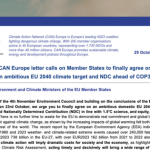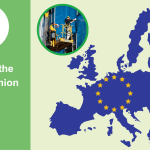The European Commission aims to make hydrogen a crucial part of becoming climate-neutral, proposing a massive scale up in the short term, but needs to focus early enough on hydrogen produced with renewable electricity, the only hydrogen able to deliver the needed climate benefits in hard to decarbonise sectors. The Hydrogen and the Energy System Integration Strategies revealed today rely on the use of fossil gas up to 2050 and “cleaning the gas sector” as stated by Energy Commissioner Kadri Simson at the press conference this morning without giving a clear end date for fossil gas use. This is in stark contrast with the need to limit temperature rise to 1.5°C and avoid dangerous climate change.
“We expected to see an immediate effort to deploy renewables based hydrogen production and invest accordingly, whereas the Hydrogen Strategy keeps the door open for the use of dirty fossil fuels and misses out on indicating a fossil gas phase-out date, which will not get us closer or faster to the Paris Agreement objective. We need to reduce our emissions by at least 65% by 2030 already and we don’t see how prolonged fossil gas use or “cleaning the gas sector” as stated by Commissioner Simson can be compatible with limiting temperature rise to 1.5°C”, said Esther Bollendorff, EU Gas Policy Coordinator at Climate Action Network (CAN) Europe.
Fossil gas based hydrogen is made by splitting gas molecules, which results in CO2 escaping into the atmosphere. That’s how more than 95% of the 8 million tonnes of hydrogen produced in the EU every year is made today, emitting between 60 million and 70 million tonnes of CO₂. The use of fossil gas across the supply chain does not only emit carbon dioxide, but also methane, a short lived and very potent greenhouse gas emitted during extraction, transport and use. Methane causes 25% of global warming experienced today with the gas and oil sector being one of the leading emitters.
In a few sub-sectors – chemicals, steel, aviation – direct electrification with renewable energy sources is technically difficult or highly inefficient. Even after having massively reduced the energy demand of these sub-sectors, they still require energy carriers with high energy density.
“A full decarbonisation of the economy will require the EU to look at energy and non-energy solutions. We should significantly reduce energy demand – it can be halved by 2050 – and multiply renewable energy supply to reach 100% by 2040 – a decade earlier than the current target – with existing and proven technologies. The measures proposed by the Energy System Integration Strategy are not sufficient to move in the needed direction to limit temperature rise to 1.5°C”, added Esther Bollendorff.
“Let’s stop beating around the bush and accept that the most straightforward way to limit temperature rise to 1.5°C and avoid catastrophic climate impacts, is to kick out all fossil gas from our energy system by 2035 at the latest, put all our efforts in energy efficiency and electrification with renewables. Vice President Timmermans stating that he cannot give an end date for fossil gas use in the hydrogen sector is more than worrying. We have an escalating crisis to address”, she concluded.
ENDS
Contact:
Cristina Dascalu, communications coordinator, cristina@caneurope.org
Note to editors:
Read the Hydrogen Strategy and the Energy System Integration
FAQs EU’s Hydrogen and Energy System Integration Strategies
Climate Action Network (CAN) Europe is Europe’s leading NGO coalition fighting dangerous climate change. With over 170 member organisations active in 38 European countries, representing over 1.500 NGOs and more than 47million citizens, CAN Europe promotes sustainable climate, energy and development policies throughout Europe.



